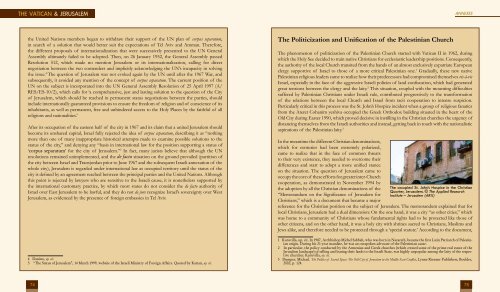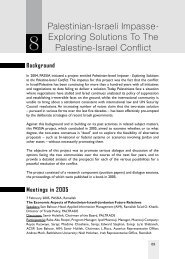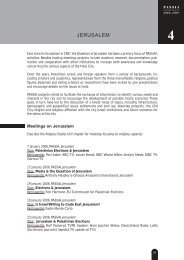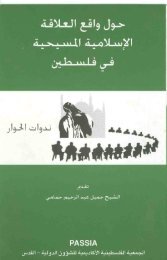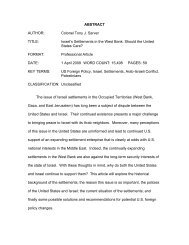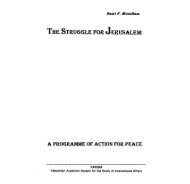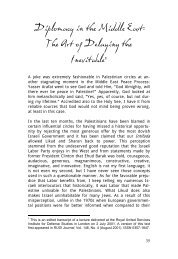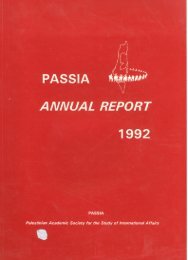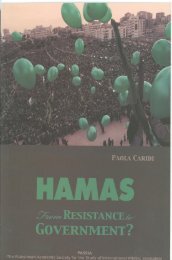The VaTican & Jerusalem - PASSIA Online Store
The VaTican & Jerusalem - PASSIA Online Store
The VaTican & Jerusalem - PASSIA Online Store
You also want an ePaper? Increase the reach of your titles
YUMPU automatically turns print PDFs into web optimized ePapers that Google loves.
<strong>The</strong> Vatican & <strong>Jerusalem</strong>annexesthe United Nations members began to withdraw their support of the UN plan of corpus separatum,in search of a solution that would better suit the expectations of Tel Aviv and Amman. <strong>The</strong>refore,the different proposals of internationalization that were successively presented to the UN GeneralAssembly ultimately failed to be adopted. <strong>The</strong>n, on 26 January 1952, the General Assembly passedResolution 512, which made no mention <strong>Jerusalem</strong> or its internationalization, calling for directnegotiation between the two contenders and implicitly acknowledging the UN’s incapacity in solvingthe issue. 4 <strong>The</strong> question of <strong>Jerusalem</strong> was not evoked again by the UN until after the 1967 War, andsubsequently, it avoided any mention of the concept of corpus separatum. <strong>The</strong> current position of theUN on the subject is incorporated into the UN General Assembly Resolution of 25 April 1997 (A/RES/ES-10/2), which calls for ‘a comprehensive, just and lasting solution to the question of the Cityof <strong>Jerusalem</strong>, which should be reached in permanent status negotiations between the parties, shouldinclude internationally guaranteed provisions to ensure the freedom of religion and of conscience of itsinhabitants, as well as permanent, free and unhindered access to the Holy Places by the faithful of allreligions and nationalities.’After its occupation of the eastern half of the city in 1967 and its claim that a united <strong>Jerusalem</strong> shouldbecome its unshared capital, Israel fully rejected the idea of corpus separatum, describing it as “nothingmore than one of many inappropriate historical attempts made to examine possible solutions to thestatus of the city,” and denying any “basis in international law for the position supporting a status of‘corpus separatum’ for the city of <strong>Jerusalem</strong>.” 5 In fact, many jurists believe that although the UNresolutions remained unimplemented, and the de facto situation on the ground prevailed (partition ofthe city between Israel and Transjordan prior to June 1967 and the subsequent Israeli annexation of thewhole city), <strong>Jerusalem</strong> is regarded under international law as occupied territory until the status of thecity is defined by an agreement reached between the principal parties and the United Nations. Althoughthis point is rejected by lawyers who are sensitive to the Israeli cause, it is nonetheless supported bythe international customary practice, by which most states do not consider the de facto authority ofIsrael over East <strong>Jerusalem</strong> to be lawful, and they do not de jure recognize Israel’s sovereignty over West<strong>Jerusalem</strong>, as evidenced by the presence of foreign embassies in Tel Aviv.4 Danino, op. cit.5 “<strong>The</strong> Status of <strong>Jerusalem</strong>”, 14 March 1999, website of the Israeli Ministry of Foreign Affairs. Quoted by Kattan, op. cit.<strong>The</strong> Politicization and Unification of the Palestinian Church<strong>The</strong> phenomenon of politicization of the Palestinian Church started with Vatican II in 1962, duringwhich the Holy See decided to train native Christians for ecclesiastic leadership positions. Consequently,the authority of the local Church transited from the hands of an almost exclusively expatriate Europeanclergy supportive of Israel to those of a more critical Palestinian one. 1 Gradually, these new nativePalestinian religious leaders came to realize how their predecessors had compromised themselves vis-à-visIsrael, especially in the face of the aggressive Israeli policies of land confiscation, which had generatedgreat tensions between the clergy and the laity. 2 This situation, coupled with the mounting difficultiessuffered by Palestinian Christians under Israeli rule, contributed progressively to the transformationof the relations between the local Church and Israel from tacit cooperation to intense suspicion.Particularly critical in this process was the St. John’s Hospice incident when a group of religious fanaticsfrom the Ateret Cohanim yeshiva occupied the Greek Orthodox building situated in the heart of theOld City during Easter 1990, which proved decisive in instilling in the Christian churches the urgency ofdistancing themselves from the Israeli authorities and instead, getting back in touch with the nationalisticaspirations of the Palestinian laity. 3In the meantime the different Christian denominations,which for centuries had been extremely polarized,came to realize that in the face of common threatsto their very existence, they needed to overcome theirdifferences and start to adopt a more unified stanceon the situation. <strong>The</strong> question of <strong>Jerusalem</strong> came tooccupy the core of these efforts for greater inter-Churchcooperation, as demonstrated in November 1994 bythe adoption by all the Christian denominations of the“Memorandum on the Significance of <strong>Jerusalem</strong> forChristians,” which is a document that became a major<strong>The</strong> occupied St. John’s Hospice in the ChristianQuarter, <strong>Jerusalem</strong>. © <strong>The</strong> Applied ResearchInstitute – <strong>Jerusalem</strong> (ARIJ)reference for the Christian position on the subject of <strong>Jerusalem</strong>. <strong>The</strong> memorandum explained that forlocal Christians, <strong>Jerusalem</strong> had a dual dimension: On the one hand, it was a city “as other cities,” whichwas home to a community of Christians whose fundamental rights had to be protected like those ofother citizens, and on the other hand, it was a holy city with shrines sacred to Christians, Muslims andJews alike, and therefore needed to be protected through a ‘special statute.’ According to the document,1 Kuruvilla, op. cit. In 1987, Archbishop Michel Sabbah, who was born in Nazareth, became the first Latin Patriarch of Palestinianorigin. During his 21-year mandate, he was an outspoken advocate of the Palestinian cause.2 In particular, the policy conducted by the Armenian and Greek churches (which owned some of the prime real estate of the<strong>Jerusalem</strong> landscape) of selling and leasing their lands to the Israeli State, was highly unpopular among the laity of the respectivechurches. Kuruvilla, op. cit.3 Dumper, Michael. <strong>The</strong> Politics of Sacred Space: <strong>The</strong> Old City of <strong>Jerusalem</strong> in the Middle East Conflict, Lynne Rienner Publishers, Boulder,2002, p. 124.74 75


